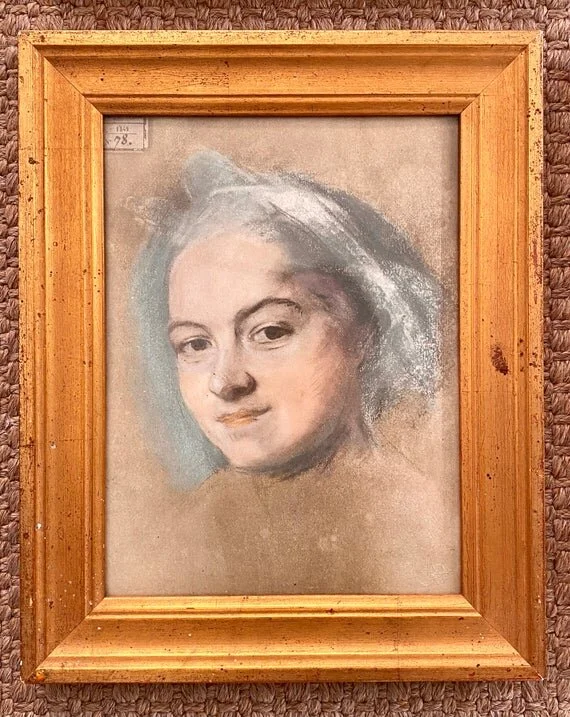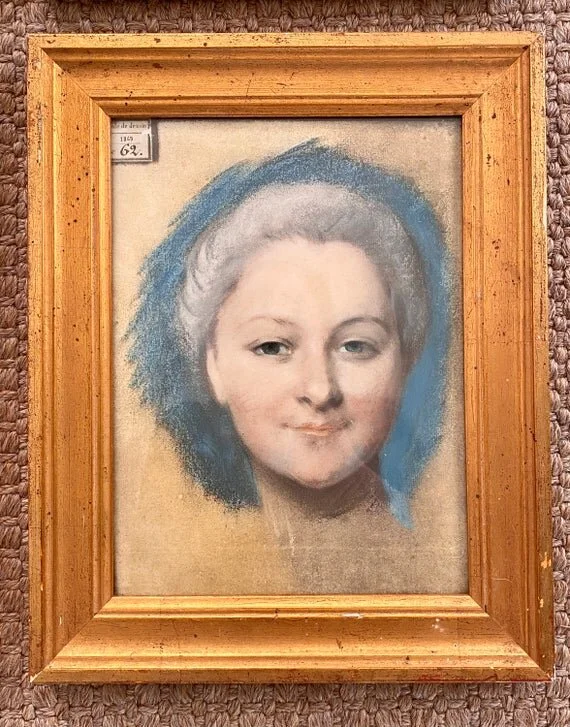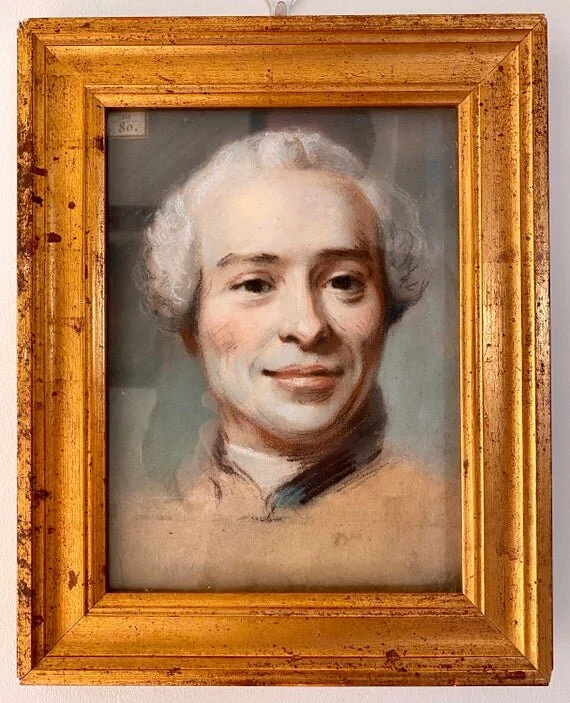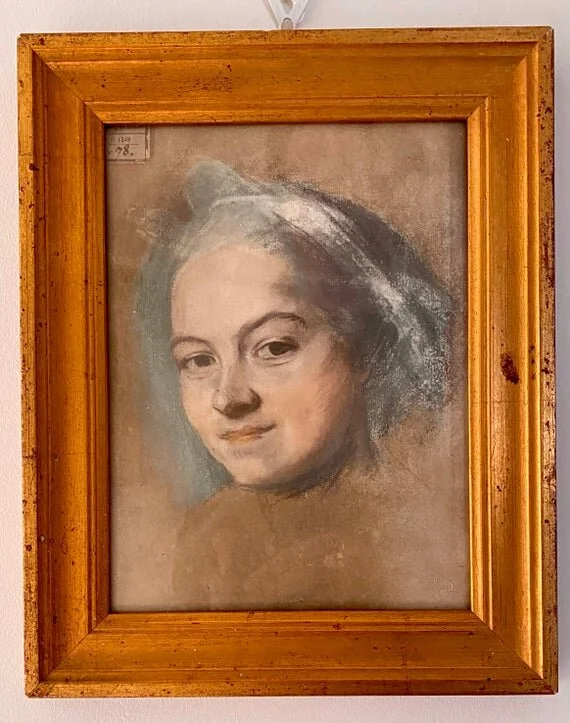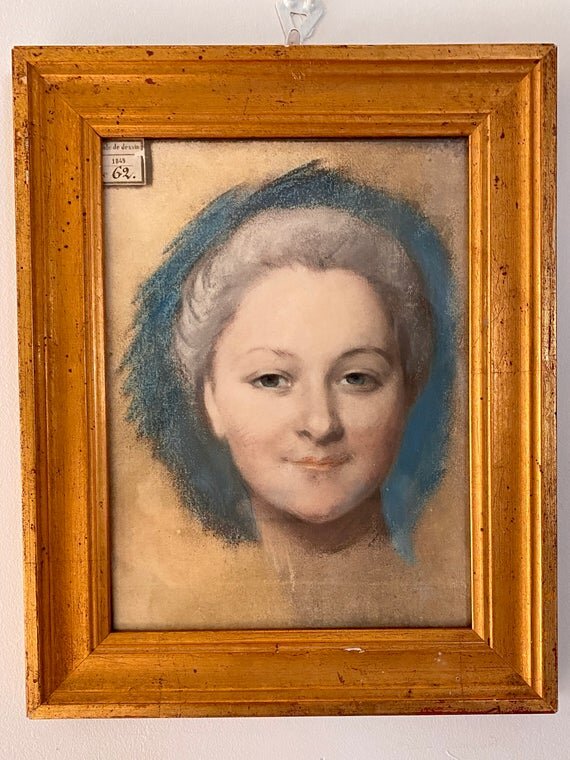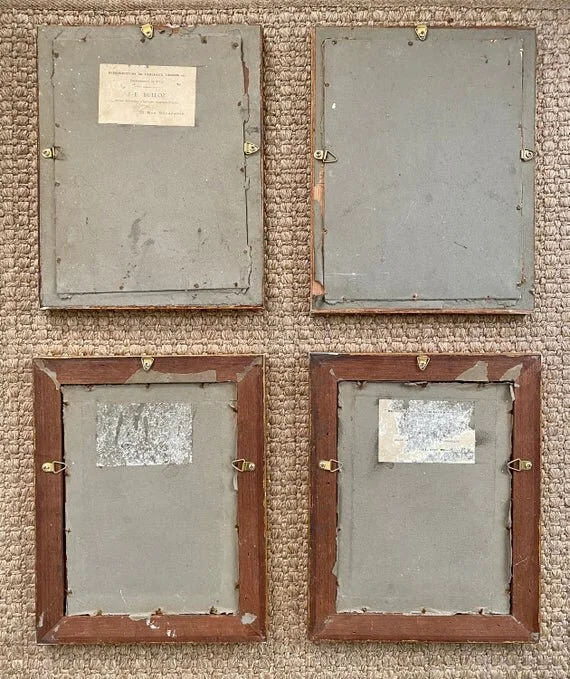Maurice Quentin de La Tour: Four Portrait Lithographs
Maurice Quentin de La Tour: Four Portrait Lithographs
Four Portrait Pastels after Maurice Quentin de La Tour
On offer is a set of four superb Rococo portrait pastels after French eighteenth-century artist Maurice Quentin de La Tour, in original gilt timber frames with original glass. These appear to be later luxurious copies, and very unusually they are hand-drawn chalk pastel over lithographs. with a dated label in each of the top left corners.
Titles:
No. 62, 1849. Study of an Unknown Woman.
No. 69, 1849. Mdme. Marie Fel 1752.
No. 78, 1849. Mdme. Madame Favart.
No. 80, 1849. Jean Le Rond d'Alembert, Mathematician, 1753.
Remaining label on back says:
REPRODUCTIONS DE TABLEAUX DESSINS, etc.
Encadrements De Style
J.–E. BULLOZ
Maison Artistique D'Éditions Photographiques
21. Rue Bonaparte, Paris
Dimensions:
Slight difference in size.
Two are: 32.75 x 26.25 cm (13 x 10.4" approx)
Two are: 32 x 25.5 cm (12.5 x 10.0" approx)
Condition:
Very good, original gilt frames are slightly chilled, scratched, rubbed, stained etc, see pictures.
About:
Maurice Quentin de La Tour (5 September 1704 – 17 February 1788) was a French Rococo portraitist who worked primarily with pastels. Among his most famous subjects were Voltaire, Rousseau, Louis XV and Madame de Pompadour.
Biography:
He was born in Saint-Quentin, the third son of a musician, François de La Tour, a Laonnois and the son of a master mason, Jean de La Tour of Laon and Saint-Quentin who died in 1674. François de La Tour apparently was successively a trumpet player for the rifle regiment of the Duc du Maine, and musician to the master of the Collegiate Church of Saint-Quentin. He is popularly said to have disapproved of his son taking up the arts, but there is nothing to support that. According to François Marandet in 2002, an apprenticeship was arranged for La Tour with a painter named Dupouch from 12 October 1719, but it is not known when this contract was terminated. Little is known of Quentin de La Tour's background until, when barely nineteen, he went to Paris indefinitely, fleeing an indiscretion concerning his cousin, Anne Bougier; by this age, he was claiming painting as his profession. After travelling briefly to England in 1725, he returned to Paris in 1727, where he was encouraged to begin working as a portraitist in pastels. His earliest known portrait, of which only an engraving by Langlois of 1731 is a testament, was that of Voltaire.
In 1737 at the Paris Salon, La Tour exhibited the portraits of Madame Boucher, the wife of the painter François Boucher, and l'Auteur qui rit or Self-Portrait, Laughing (musée du Louvre), the first of a splendid series of 150 portraits that served as one of the glories of the Paris Salon for the next 36 years. Nevertheless, the painter Joseph Ducreux claimed to be his only student (although this is unlikely). On 25 May 1737 La Tour was officially recognised (agréé) by the Royal Academy of Painting and Sculpture, and soon attracted the attention of the French court. According to Jeffares, he had an apartment in the Palais du Louvre in 1745, although his portraits for the royal family had ceased by the late 1760s. La Tour was popularly perceived as endowing his sitters with a distinctive charm and intelligence, while his delicate but sure touch with the pastel medium rendered a pleasing softness to their features.
Contemporary accounts describe Quentin de La Tour's nature as lively, good-humoured, but eccentric. In many of his self-portraits, he depicts himself smiling out from the frame towards the viewer; Laura Cumming states of La Tour that "where other artists make heavy weather of portraying themselves, he takes the task lightly and seems to have produced more glad-faced self-portraits than any other artist". However, of an excessively nervous disposition (which eventually descended into dementia), and an exacting practitioner, he has also been described as over-engineering his work, to the point of spoiling it.
As La Tour's wealth increased from his commissions, so did his philanthropy; he founded a school for drawing in his native Saint-Quentin and donated towards poor women in confinement, and disabled and ageing artisans and artists. He was also advisor and benefactor to the Royal Academy of Painting and Sculpture in Paris, and the Academy of Sciences and Belles Lettres of Amiens. Eventually confined to his home and the care of his brother, Jean-François, because of encroaching mental illness, he retired at the age of 80 to Saint-Quentin, where he died intestate at the age of 83 (he had revoked earlier wills). Jean-François de La Tour (d. 1807), chevalier de l'ordre royal militaire de Saint-Louis, was the natural heir to his estate.
The musée Antoine Lécuyer in the town of Saint-Quentin is home to many of La Tour's pastels from his own studio; it offers the visitor not only a synthesis of La Tour's life and work but also a selective and concentrated view of French eighteenth-century society and costume.




